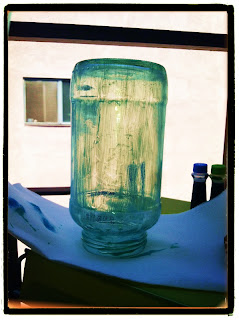But don't feel bad for me. I'm laying in bed typing this at 11am, watching The Price is Right.
Meanwhile, and the point to this post, is that I have finished a side table make over that I had planned as my unemployment project for this hiatus.
 |
| via Pinterest |
I love this color on an end table, along with all this detail, and matched with the mirror above. It feels very Mediterranean. I am starting to try to branch out and get in touch with my colorful side - as I tend to always veer toward earth tones - and what better way to do that than pull things from my Mediterranean heritage!?
I was given a free end table and I was excited to use the Martha Stewart Interior Paint in the color of Palmetto, which is the same color used on the table above.
The end table was made of particle board and wood laminate. After much research, I decided that I still need to sand it down to get rid of the light gloss coating on top. I wanted the final product to look old and aged, so I lightly sanded the entire table, but then took a hammer and dinged up the edges of the table top, the doors and drawer.
Next, I wanted there to be a little bit more detail in the wood, that didn't currently exist, but that you would normally see in authentic Mediterranean style furniture. I've recently become aware of paintable wallpaper that comes in different patterns. The great thing about paintable wall paper is that the patterns are very similar to some wood work type patterns. I found this roll of paintable wallpaper trim that had a pretty pattern at Lowes (and that is the only store I found it at). I originally bought the trim to use on an Ikea Hack, to put on the drawers of a MALM dresser I have, just to spice it up. I haven't gotten that far yet, and after seeing how easy this project was, maybe I will pick that project back up.
I cut the center shape out of the wall paper trim, so that I could just give the center of the doors some detail. Like any self stick wall paper, you soak this in luke warm water, fold it onto its sticky self for a few minutes, which will make the glue tacky.
Once the time is up, you position the wall paper onto the door. It doesn't seem like it will stay on, as it is easily reposition-able and I was worried it wouldn't be strong enough. Once you have the positioning down, just leave it alone for a couple of hours. Sure enough, it will stick.
Once I got the Palmetto paint on ( I did 2 coats overall), I got to mixing my glaze for antiquing. I chose a light brown that I thought would look well with this green to give it just a bit of an "i've been sitting around for a while" aged look, but still be pretty. A lot of people will use an almost black color to age, and it would be more effective and more visible, but I chose for my first ever antiquing glaze to go a bit more subtle. You mix 1 part paint color with 3 parts glaze. I don't remember exactly what brown paint I chose, but I used Behr Faux Glaze for the application.
So, you take your mixture and a bucket of water and a washcloth. You paint on the glaze mixture, as thick or as lightly as you wish. Moments after, you take the wet cloth and wipe it off. As long as you don't press too hard, the glaze will stick in all the small dings and nooks. Go over it as many times as you want. I paid extra attention to the edges and corners, as that would probably naturally have been handled most. I also lightly brushed all over just to age the paint color itself, but wiped away immediately, and did that over and over until I liked what I saw.
The painted wallpaper looks really great and appears to be part of the doors once all is said and done. There are a lot of small spaces that made it great for the glaze.
Once finished and dry, I re applied the original hardware. I was going to get some fun vintage hardware from Anthropologie, but the dimensions for the original hardware holes were an awkward measurement that most hardware did not match. And the holes for the knobs on the doors were far too close to each other. I didn't feel like filling holes and drilling new ones, and the original hardware looked antique-y enough for me.
VOILA!
Two things to note: I used a spray sealer in order to make it water proof and/or scratch resistant. And it didn't work. I am currently patching the top and I bought a Polyurethane protective water based paint to coat on the top. I got it in a satin finish so that it wasn't glossy and a massively different finish to the rest of it, but a nice finish none the less.
Secondly, If i had done anything else differently, I probably would have liked to maybe cut a strip of paintable wallpaper the length of the drawer, to add some extra detail. Still possible if I decide to up date it. But for now, I am pretty happy with the outcome! :)











































